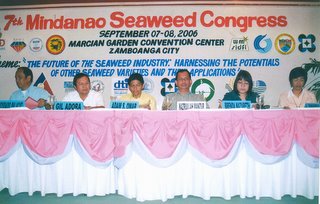WMSIDFI, DA, DOST, SEAFDEC, ZSCMST, BFAR, City Agriculturist sign Memorandum of Understanding

Officials of the Western Mindanao Seaweed Industry Development Foundation Inc., Bureau of Fisheries and Aquatic Resources, Department of Science and Technology, Department of Trade Industry, Office of the City Agriculturist, Department of Labor and Employment are among the signatories of a Memorandum of Understanding for the establishment and operation of the Seaweed Genebank and Land-based Nurseries at Zamboanga State College of Marine Sciences and Technology based in Barangay Rio Hondo. (HADER GLANG)
The Western Mindanao Seaweed Industry Development Foundation, the Southeast Asian Fisheries Development Center, Department of Science and Technology, Department of Agriculture, Bureau of Fisheries and Aquatic Resources, Zamboanga State College of Marine Science and Technology, Office of the City Agriculturist of Zamboanga have signed a Memorandum of Understanding to establish a seaweed gene bank and a land-based seaweed nursery in Zamboanga City.
Based on the MOU, the following agencies have agreed to be a party with their corresponding commitments:
1. ZSCMST based in Barangay Rio Hondo, Zamboanga City will provide the appropriate space, facilities, personnel, and available resources in the establishment and operation of the Seaweed Genebank and Land-based Nurseries which is called the PROJECT.
2. SEAFDEC Aquaculture Department based in Tigbauan, Iloilo will provide appropriate technical, coordinative, supervisory, and advocacy assistances to ZSCMST in the establishment and cooperation of the PROJECT particularly in the development and conduct of a R&D agenda to support the seaweed as well as the mariculture industry.
3. BFAR Regional Office 9 will provide appropriate technical, facilitative, coordinative, funding, and networking assistance in the distribution and propagation of the various seaweed cultivars produced by the PROJECT to strategically located sea-based seaweed nurseries in Zamboanga Peninsula.
4. Office of the City Agriculturist will provide appropriate technical services to farmers, conduct trainings and extension services to seaweed farmers and to conduct farm demonstrations of the various seaweeds cultivars produced by the PROJECT to strategically located sea-based seaweed nurseries in Zamboanga City.
5. DOST Regional Office 9 will provide appropriate funding and technical support for the PROJECT which will be determined in a series of meetings that will later be called for about the PROJECT.
6. DA Regional Office 9 will provide appropriate facilitative, coordinative, networking, and agri-business and marketing assistance for the PROJECT.
7. WMSIDFI will provide appropriate facilitative, coordinative, networking, secretariat, and funding assistance for the PROJECT and in the development and implementation of its sustainable revenue program.
The signatories also agreed to meet immediately to: identify and commit respective resources that can be shared for the PROJECT; prepare and implement a Work and Financial Plan specifying the responsible agencies, budget, and the time-frame which will be covered by a Memorandum of Agreement; and create an executive committee that will conduct regular periodic meetings in assessing PROJECT’s implementation and in formulating commensurate action plans and interventions.
Adam Omar, chairman of WMSIDFI, said that of the estimated 182,000 metric tons world production in 2005 of dried Kappaphycus seaweed also known as “cottonii” by trade, the Philippines accounted for 60% (108,000mt), Indonesia 36% (66,000mt), and the rest Vietnam, Cambodia, and Tanzania.
But the increasing production from Indonesia and Vietnam and Cambodia since 2001 has eaten up the Philippines’s share of the world market by at least 5% annually, according to Omar.
Data shows that Philippine production for the past 10 years has remained stagnant and has not exceeded 130,000 mt of raw dried seaweed annually that could be partly attributed to low quality of seaweed seedlings or propagules and high incidence of low farm productivity.
“These problems can be addressed through the establishment of strategically located seaweed gene banks and land-based nurseries linked with sea-based nurseries,” Mr. Omar said.
The presence of a gene bank fully supported by land-based and sea-based nurseries or seedling banks will: ensure continuous supply of better quality seed-stocks; conserve genetic biodiversity of carrageenan-producing seaweeds; and ensure a pool of genetic materials for biotechnology in the future.
These facilities will: encourage seaweed growers to increase seaweed production either through area expansion or increase in yield or productivity of existing farms; provide livelihood activities and increase income of coastal communities; and propel the nation as the leading producer of high quality seaweed and carrageenan. (ZS)
No comments:
Post a Comment